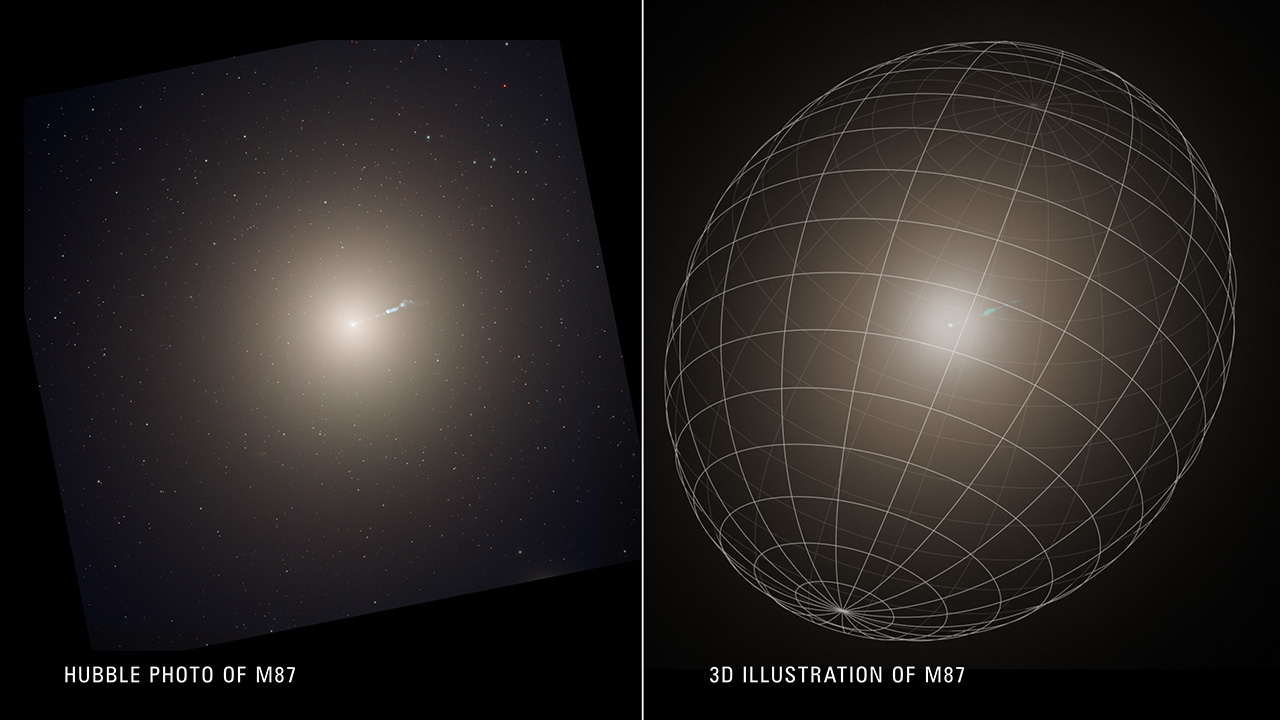Enormous M87 galaxy looks like giant potato in 1st-ever 3D map (image)
It's a grand new view of M87, the first galaxy to have its supermassive black hole directly imaged.
A massive elliptical galaxy has been mapped in three dimensions for the first time, revealing it has a shape similar to a monstrous cosmic potato.
The model of Messier 87 (M87), which is one of the largest known elliptical galaxies, was created using data from the W.M. Keck Observatory on Maunakea in Hawaii and the Hubble Space Telescope.
This work revealed that the galaxy — which, at around 55 million light-years away, is also one of the closest elliptical galaxies to Earth — is not symmetrical in shape. Instead, M87 has a triaxial shape, much like a humble potato, the research team found.
Since the 1920s, astronomers have classified galaxies according to their shape. However, elliptical galaxies, which tend to look like smooth, near-featureless blobs from afar, have been tough to categorize.
Researchers have therefore been keen to determine the true shape of elliptical galaxies for some time. Such information could help reveal how these galaxies, and the massive black holes at their cores, form. This new 3D model helps astronomers get a better look at the shape of what is considered a prototypical elliptical galaxy.
Related: Black holes of the universe (images)
A better measurement of a supermassive black hole
The team created the new 3D plot of M87 by measuring the motion of stars around its central supermassive black hole, known as M87*, which made history in 2019 when it became the first black hole ever imaged directly, a feat pulled off by the Event Horizon Telescope (EHT) collaboration.
Breaking space news, the latest updates on rocket launches, skywatching events and more!
The stellar motion provided new information about the shape of M87 and how it rotates. In addition to this, the motion of the stars allowed scientists to make a new measurement of the mass of the object they orbit, M87*.
The team estimated that the supermassive black hole is about 5.4 billion times more massive than the sun. That's slightly lower than the previous figure of 6.5 billion solar masses, which was calculated using EHT images of the black hole and Einstein's theory of general relativity.
As they continued to map the stellar velocities and the position of the M87 stars, the astronomers created a 3D view of the elliptical galaxy. This map, together with the new estimation of M87*'s mass, could help researchers calculate the speed at which the black hole is rotating.
"Now that we know the direction of the net rotation of stars in M87 and have an updated mass of the black hole, we can combine this information with data from the Event Horizon Telescope to constrain the spin," the lead investigator of the new research, Chung-Pei Ma of the University of California, Berkeley, said in a statement.
M87 has around 10 times the mass of our own galaxy, the Milky Way, with scientists theorizing that the elliptical galaxy grew as the result of a chain of mergers with other galaxies. As M87 cannibalized these galaxies, its supermassive black hole merged with other central black holes, also growing to a monstrous size.
M87*'s gravity now dominates an area at the center of M87 about 3,000 light-years wide. The team used the Keck II Telescope to observe stars in a 70,000 light-year-wide region that includes this central M87*-dominated area. While the instrument couldn't individually resolve these stars because of how far away M87 is, it did observe the spectra of the stars. This information revealed the range of velocities the team needed to calculate the mass of the object the stars are orbiting.
"It's sort of like looking at a swarm of 100 billion bees," Ma said. "Though we are looking at them from a distance and can't discern individual bees, we are getting very detailed information about their collective velocities."
The data from Keck, collected between 2020 and 2022, was combined with Hubble observations of star brightness from the same region. This combined data set was then compared to computer model predictions of how stars move around the center of a triaxial-shaped galaxy. From the best fit of this data, the team estimated the black hole's mass.
"Knowing the 3D shape of the 'swarming bees' enabled us to obtain a more robust dynamical measurement of the mass of the central black hole that is governing the bees' orbiting velocities," Ma concluded. "This may point toward a certain direction and range of spin for the black hole, which would be remarkable."
The team's research was published in March in the Astrophysical Journal Letters.
Follow us on Twitter @Spacedotcom or on Facebook.

Robert Lea is a science journalist in the U.K. whose articles have been published in Physics World, New Scientist, Astronomy Magazine, All About Space, Newsweek and ZME Science. He also writes about science communication for Elsevier and the European Journal of Physics. Rob holds a bachelor of science degree in physics and astronomy from the U.K.’s Open University. Follow him on Twitter @sciencef1rst.

